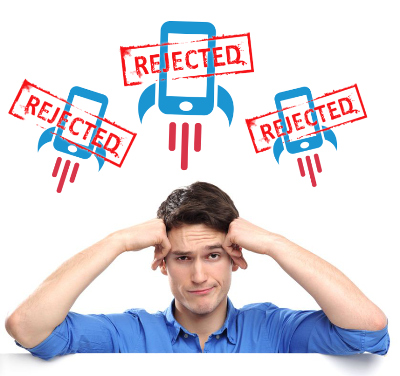
The dreaded rejection – you’ve commissioned your mobile app, developed it, tested it, then Apple rejects your creation – because you inadvertently violated one of their rules.
It happens – rejection is never pleasant. I’ve personally dealt with mobile app rejection on several occasions, in all cases at no additional cost to the client. A lot of the time the rejection occurs because the reviewer misunderstood app functionality – on more than one occasion I’ve negotiated a solution which did not require any change to the app functionality. In other cases, a minor change to functionality is required, to bring the app into compliance. Sometimes an app is rejected because of a malfunction – in which case the reviewer is doing you a favour, helping you to discover and correct a mistake, before your app receives negative reviews from the public.
Venture Beat News has written an excellent article providing 5 tips to avoid rejection.
1. Test, test, and test.
In every scenario for successful app submission, it all boils down to testing app performance and user experience. From bugs to crashes, the list of app rejection reasons is ridiculously long. The recent Forrester report on mobile app testing confirms that “successful app testing requires real devices rather than emulators; many development teams have learned this the hard way.” Engaging, high-quality apps can do wonders for your brand reputation, while poor-quality apps turn off even the most loyal customers. So do yourself a big favor. When you have built and tested your app to absolute perfection… test it again!2. Plan for patience
Possibly the most frustrating aspect of app store submission is the time it takes to review. The inconsistency can be particularly maddening. The Apple App Store review process can take as few as 4 days, as many as 14, or anywhere in between. And that’s if your app gets accepted the first time. Google Play doesn’t take as long, but patience is still a virtue here. Unless you have an app store reviewer on your payroll, it’s a very good idea to plan for a lengthy review process, and hope for the best.3. Understand the submission fields ahead of time
Submitting your app requires you to fill out a lot of information, and neglecting this step until the last minute has caused a review delay for many an app. Be sure to research all the fields you’ll fill out (app description, categories, keywords, copyright, screen shots, etc.) and get a good head start before you’re ready to submit, and eliminate this avoidable delay.4. Monitor the latest app store updates
Apple has an annoying habit of changing their acceptance rules frequently, especially after new OS releases. This can easily lead to a lot of app rejection headaches, so it is important to have someone keep on top of the latest updates. Ensure that someone on your team is continually familiar with the Apple Store and Google Play submission rules, and save yourself some hair.5. Create your own app store
Unlike individual developers, companies don’t necessarily have to subject themselves to the verdicts of the mobile elite. Enterprise app stores are a growing trend in today’s mobile world, as companies are finding the capability to host and distribute their apps internally. If you have the right cloud platform, this is a great way to make life easier, both for yourself and your end users.
If you would like more information on how to avoid having your newly developed mobile app rejected by mobile app store review, and what to do about it if your receive the dreaded rejection notice, please Contact Me.